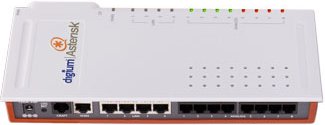Asterisk-based IP-PBX box gains GUI front-end
Dec 3, 2009 — by Eric Brown — from the LinuxDevices Archive — 51 viewsPika Technologies announced a new FreePBX image for its Linux-based Pika Warp IP-PBX appliance, which offers both VoIP and PSTN functionality. The Warp Enterprise distribution combines the previous open source Asterisk PBX software stack with an image based on the FreePBX GUI for Asterisk, the company says.
Pika announced its Pika Warp Appliance for Linux device (pictured below, at right) in 2007, and in June 2008 shipped it with a cross-compiling SDK (software development kit) based on Denx Linux and the open source Asterisk PBX software stack.
Compared to PC-based, "data centric" PBX competitors, the Appliance is touted as offering more features, including support for 32 simultaneous calls, music-on-hold (MOH), failover to analog operation, integrated voice response (IVR), predictive dialing, appointment reminders, and paging. 
Designed for small to medium-sized businesses (SMBs), the new Warp Enterprise runs on the original 9.3 x 6.7 x 2.2-inch Pika Warp device, which is equipped with a 533MHz AMCC Power PC 440EP, a security-enhanced version of the PowerPC 440. It comes standard with 256MB of RAM, 4MB NOR flash, 256MB of NAND flash, and is expandable via an SD card slot. I/O includes Ethernet, USB, and serial ports, plus an FXS port, an optional fax port, and up to two optional expansion modules for various telephony interfaces.
Warp Enterprise incorporates a version of the FreePBX graphical front-end for Asterisk, so system integrators and Asterisk resellers no longer have to integrate this more user-friendly PBX interface themselves. Based on a Linux 2.6.26.5 kernel, and offering pre-loaded Asterisk 1.4.25.1 and FreePBX 2.5.1 images, the software offers VoIP functionality as well as analog station and PSTN interfaces. The modular configuration can include VoIP stations and trunks, as well as up to nine ports of a combination of FXO, FXS, and BRI lines, with cellular GSM integration promised in the future. Warp Enterprise also supports up to 40 IP endpoints (trunks and stations) and six trunks, says Pika.
The GUI-enabled FreePBX functions include IVR, find me, conferencing, backup/restore, and Manager (Asterisk API), says Pika. System tools for Warp Enterprise are said to include network configuration, email server configuration, appliance reboot, and Pika hardware channels display. Also offered is a Fax for Warp app that converts TIFF or PDF files to fax.
Digium Asterisk and Fonality Trixbox appliances
Other GUI-enabled front-ends for Asterisk that incorporate versions of FreePBX include Digium's AsteriskNow and Fonality's Trixbox (formerly [email protected]). Both companies supply optional, Linux-based hardware devices to run their softw are. Digium, which was founded by Asterisk originator Mark Spencer, has sold its Asterisk Appliance (shown at right) for over two years now. More recently, Fonality, whose Trixbox CE and Trixbox Pro distributions are based on CentOS Linux, introduced its Trixbox Appliance (see image below).
are. Digium, which was founded by Asterisk originator Mark Spencer, has sold its Asterisk Appliance (shown at right) for over two years now. More recently, Fonality, whose Trixbox CE and Trixbox Pro distributions are based on CentOS Linux, introduced its Trixbox Appliance (see image below).

Fonality's Trixbox Appliance
Availability
Pika Warp Enterprise appears to be available now for "lead customers," but pricing was not listed. More information may be found here.
More on the Digium Asterisk Appliance may be found here, and more on Fonality's Trixbox Appliance should be here.
This article was originally published on LinuxDevices.com and has been donated to the open source community by QuinStreet Inc. Please visit LinuxToday.com for up-to-date news and articles about Linux and open source.